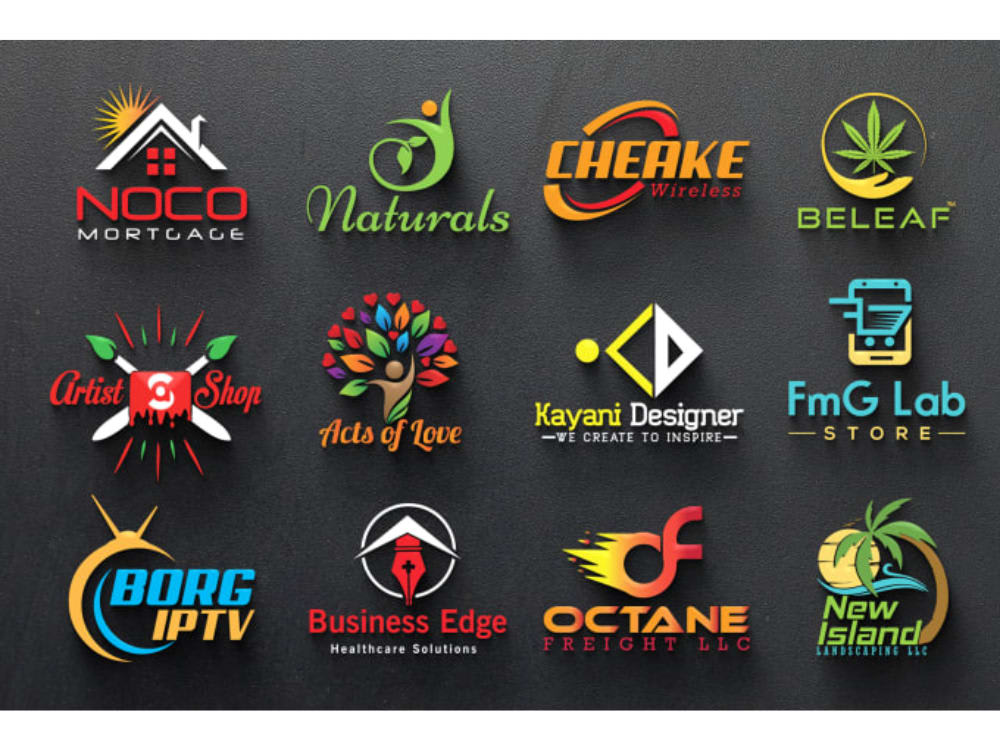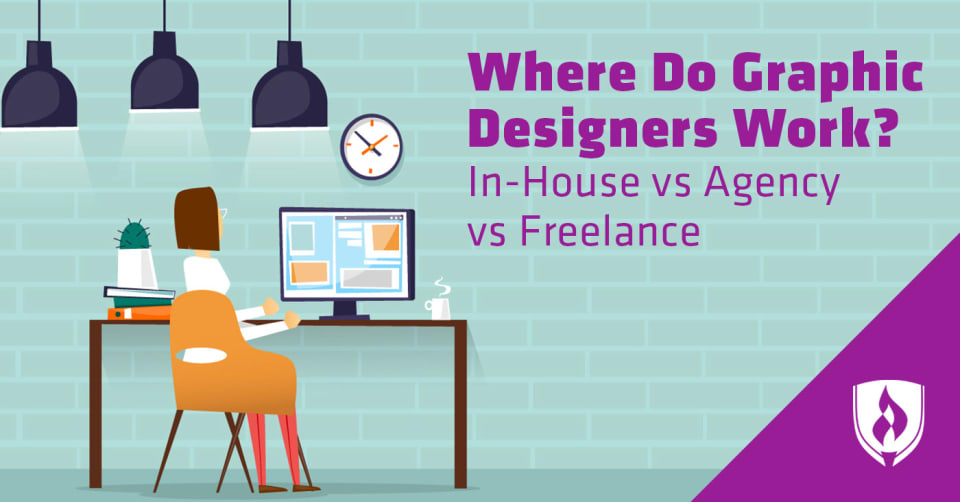Logo designers work in various settings, from freelance to corporate offices. They bring brands to life with creative visuals.
Understanding where logo designers work can help you decide the best path for your career or find the right designer for your project. Whether it’s freelancing from home, working in an agency, or being part of a company’s in-house team, each environment offers unique experiences and opportunities. Different settings can influence the design process, client interactions, and project management. Knowing these options can guide you to the right place for your skills or help you choose the best designer for your needs. Explore the various workplaces for logo designers and see which fits your goals and lifestyle. For more information on hiring a logo designer, visit this Fiverr link.
Introduction To Logo Designing Careers
Logo designing is an exciting career path. It blends creativity with strategic thinking. Professionals in this field create visual symbols. These symbols represent brands, companies, and organizations.
Understanding The Role Of A Logo Designer
A logo designer’s job is more than just creating images. They conceptualize and design logos. Their work conveys the brand’s identity and message.
Logo designers often work with clients. They understand the client’s vision and requirements. This collaboration ensures the final design meets the client’s needs.
Here are some key responsibilities:
- Researching the industry and target audience
- Brainstorming and sketching initial ideas
- Creating digital versions of logo concepts
- Revising designs based on feedback
- Delivering the final logo in various formats
Importance Of Logo Design In Branding
A well-designed logo is crucial for any brand. It is often the first impression customers have of a company. A logo communicates the brand’s core values and personality.
Here are some reasons why logo design is important:
- Brand Recognition: A distinctive logo makes a brand easily recognizable.
- Professionalism: A polished logo conveys professionalism and trustworthiness.
- Memorability: A memorable logo sticks in customers’ minds, promoting brand loyalty.
- Consistency: A logo helps maintain brand consistency across different platforms and materials.
In summary, logo designers play a vital role in branding. They create designs that resonate with audiences. Their work helps businesses establish a strong brand identity.

Credit: www.upwork.com
In-house Logo Designers
In-house logo designers work directly for a specific company or brand. They are part of the company’s internal design team. This role offers stability and a clear understanding of the brand’s identity.
Corporate Design Departments
Many large corporations have dedicated design departments. These departments handle various design needs, including logo creation. In-house logo designers collaborate with marketing and branding teams. They ensure the logo aligns with the company’s vision and goals.
| Company | Industry | Design Focus |
|---|---|---|
| Tech | Innovative and User-Friendly | |
| Coca-Cola | Beverage | Classic and Timeless |
| Nike | Sportswear | Dynamic and Modern |
Advantages Of Working In-house
Working in-house has several benefits:
- Job Stability: In-house positions offer more security.
- Consistent Work: Designers work on the same brand, ensuring consistency.
- Team Collaboration: Regular interaction with marketing and other departments.
In-house designers often have access to better resources. They also have a deeper understanding of the company’s brand.
Challenges Of In-house Positions
Despite the benefits, in-house positions have challenges:
- Limited Creativity: Designers might feel restricted by brand guidelines.
- Repetitive Work: Working on the same brand can become monotonous.
- Pressure: High expectations from the company can be stressful.
In-house designers must balance creativity with brand consistency. They need to innovate while adhering to established guidelines.
Freelance Logo Designers
Freelancing is a popular choice for many logo designers. It offers flexibility and the opportunity to work with diverse clients. Freelance logo designers are responsible for creating unique and memorable logos for businesses of all sizes. They often work from home, co-working spaces, or anywhere with a stable internet connection.
Benefits Of Freelancing
Freelancing as a logo designer comes with several advantages:
- Flexibility: Freelancers can set their own schedules and work at their own pace.
- Variety of Projects: They have the opportunity to work on different projects, which helps in building a diverse portfolio.
- Independence: Freelancers can choose their clients and projects, giving them more control over their career.
- Higher Earnings Potential: With no middleman, freelancers can often earn more per project than in-house designers.
Common Platforms For Freelance Work
Several platforms connect freelance logo designers with clients:
| Platform | Description |
|---|---|
| Fiverr | A popular platform for freelance services, including logo design. |
| Upwork | A platform for freelancers to find various design projects. |
| 99designs | A specialized platform for designers to find logo design contests. |
Managing Client Relationships
Building strong client relationships is crucial for freelance logo designers. Here are some tips:
- Clear Communication: Ensure you understand the client’s vision and keep them updated throughout the project.
- Professionalism: Meet deadlines, be polite, and handle feedback gracefully.
- Quality Work: Deliver high-quality designs that meet or exceed client expectations.
- Follow-Up: After completing a project, follow up to get feedback and build long-term relationships.
Design Agencies
Logo designers often find exciting opportunities within design agencies. These agencies offer a structured environment where creativity and collaboration thrive. Working in a design agency allows logo designers to engage with diverse projects and clients. This environment fosters professional growth and skill enhancement.
Types Of Design Agencies
There are various types of design agencies where logo designers can work. Here are some common types:
- Full-Service Agencies: These agencies offer a wide range of services including branding, web design, and marketing.
- Branding Agencies: Focus primarily on creating and managing brands, including logo design.
- Creative Boutiques: Smaller agencies that specialize in niche markets and creative solutions.
- Digital Agencies: Concentrate on digital solutions like web development, app design, and online marketing.
Roles And Responsibilities Within Agencies
Within design agencies, logo designers have specific roles and responsibilities. These may include:
- Client Meetings: Understanding client needs and project requirements.
- Concept Development: Brainstorming and creating initial design concepts.
- Design Execution: Using software to create final logos.
- Collaboration: Working with other team members like graphic designers, copywriters, and project managers.
- Revisions: Making changes based on client feedback.
Career Growth In Agency Settings
Working in a design agency offers numerous opportunities for career growth. Here’s how:
- Skill Development: Gain hands-on experience with various design tools and techniques.
- Networking: Build connections with industry professionals and clients.
- Advancement Opportunities: Potential to move up to senior designer or creative director roles.
- Portfolio Building: Work on diverse projects that enhance your portfolio.
Design agencies provide a dynamic environment where logo designers can thrive and grow professionally.
Remote Work Opportunities
Remote work has become a significant trend in the world of logo designing. Many designers now work from the comfort of their homes, leveraging technology to collaborate with clients globally. Remote work offers flexibility, a diverse client base, and the ability to balance work and personal life more effectively.
Rise Of Remote Logo Designing Jobs
The demand for remote logo designing jobs has risen dramatically. This growth is due to the increasing acceptance of remote work by companies and the availability of online platforms like Fiverr. These platforms connect designers with clients from all over the world, providing a steady stream of opportunities.
Many designers prefer remote work because it eliminates the need for commuting and allows for a more flexible schedule. This flexibility enables designers to take on multiple projects and clients, increasing their income potential and professional growth.
Tools And Platforms For Remote Collaboration
Successful remote logo designers rely on various tools and platforms to collaborate with clients and teams. Some of the essential tools include:
- Fiverr: A popular platform for freelancers to find logo design projects.
- Slack: For real-time communication with clients and team members.
- Trello: To manage project tasks and deadlines efficiently.
- Zoom: For virtual meetings and presentations.
- Adobe Creative Cloud: Essential software for creating high-quality logo designs.
Using these tools, designers can maintain clear communication, manage their workload, and deliver projects on time.
Balancing Work And Personal Life
One of the significant advantages of remote work is the ability to balance work and personal life. Logo designers can set their own schedules, allowing them to attend to personal commitments without compromising their professional responsibilities.
To achieve a healthy balance, designers can:
- Set specific work hours and stick to them.
- Create a dedicated workspace free from distractions.
- Take regular breaks to avoid burnout.
- Prioritize tasks using tools like Trello.
- Communicate availability clearly with clients.
By following these practices, remote logo designers can maintain productivity while enjoying a fulfilling personal life.

Credit: www.rasmussen.edu
Educational Institutions
Logo designers find fulfilling careers in educational institutions. These environments offer unique opportunities to shape the next generation of designers. Working in education allows logo designers to share their knowledge and experience while continuing their own professional growth.
Teaching Logo Design
Teaching logo design in schools or universities involves creating lesson plans and conducting classes. Instructors introduce students to the fundamentals of design, including color theory, typography, and branding principles. Hands-on projects help students apply what they learn in real-world scenarios.
Experienced designers can inspire students by sharing personal industry experiences. This makes lessons more engaging and relevant.
Developing Curriculum And Workshops
Logo designers in educational settings often contribute to curriculum development. They ensure that the courses remain up-to-date with industry trends and technologies. This might involve collaborating with other faculty members and industry experts.
Workshops are another key aspect. These intensive sessions focus on specific skills or techniques. They give students and professionals the chance to deepen their knowledge in a concentrated time frame.
Benefits Of Working In Education
- Job Stability: Educational institutions offer stable employment compared to freelance work.
- Professional Growth: Teaching helps designers stay current with industry advancements.
- Inspiring Others: Educators have the chance to inspire and mentor the next generation of designers.
Overall, working in education provides a rewarding career path for logo designers. It combines the joy of teaching with ongoing professional development.
Community And Non-profit Organizations
Logo designers often find fulfilling work in community and non-profit organizations. These roles allow them to contribute to meaningful causes and help organizations enhance their visibility and mission.
Designing For Social Causes
Designing logos for social causes is unique and rewarding. It requires understanding the mission and values of the organization. These logos often reflect the heart of the cause, whether it’s environmental conservation, social justice, or community development. A well-designed logo can communicate the essence of the organization and inspire action.
| Key Elements | Importance |
|---|---|
| Symbolism | Represents the core values |
| Colors | Conveys the mood and tone |
| Simplicity | Ensures easy recognition |
Impact Of Logos On Community Engagement
A powerful logo can significantly impact community engagement. It serves as a visual representation of the organization’s mission. A memorable logo can foster trust and loyalty among community members. It can also attract new supporters and volunteers, enhancing the reach and impact of the organization’s efforts.
- Builds trust and recognition
- Encourages volunteer participation
- Inspires community support
Opportunities And Challenges In Non-profit Work
Working with non-profits offers various opportunities. Designers can work on diverse projects and make a positive impact. They can build a portfolio that showcases their ability to create meaningful designs.
However, there are challenges. Non-profits often have limited budgets, which can constrain design options. Designers must be creative and resourceful to deliver high-quality work within these constraints. Despite these challenges, the rewards of seeing their designs help an important cause can be immense.
- Opportunity to work on diverse projects
- Chance to make a positive impact
- Budget constraints
- Need for creativity and resourcefulness
In summary, logo designers in community and non-profit organizations play a crucial role. They help communicate the mission and values of these organizations, contributing to their success and impact.

Credit: www.designcrowd.com
Entrepreneurial Ventures
Many logo designers choose to embark on entrepreneurial ventures for greater control and flexibility. Starting your own business can be rewarding. It allows you to shape your career and build your brand.
Starting Your Own Design Business
Starting your own design business involves several steps. First, choose a business name that reflects your brand. Register your business and secure any necessary licenses. Set up a professional website to showcase your portfolio. Invest in essential tools like Adobe Illustrator or CorelDRAW.
Create a dedicated workspace that enhances your creativity. It should be free from distractions. This workspace is critical for productivity and quality output. Design a business plan outlining your services, target audience, and financial projections.
Building A Client Base
Building a client base is crucial for your business. Start by networking with local businesses and designers. Offer your services to friends and family to gain initial exposure. Use social media platforms like LinkedIn, Instagram, and Facebook to showcase your work.
- Join online communities and forums related to design.
- Attend local business events and trade shows.
- Offer free workshops or webinars to demonstrate your expertise.
Keep a record of satisfied clients and ask for referrals. Positive word-of-mouth can significantly boost your client base.
Marketing And Scaling Your Business
Marketing your business is essential for growth. Use SEO strategies to improve your website’s visibility on search engines. Write blog posts about your design process, industry trends, and success stories. This content can attract potential clients and establish your authority.
Consider using paid advertising on social media and Google Ads. These platforms can target specific demographics. Create email newsletters to keep in touch with your audience. Offer promotions and discounts to encourage repeat business.
Scaling your business involves expanding your services. Hire additional designers to handle larger projects. Invest in advanced software and tools to improve efficiency. Continuously monitor industry trends and adapt your services accordingly.
Use these strategies to grow and maintain a successful design business. Entrepreneurship in logo design can be both challenging and rewarding. It provides opportunities for growth and innovation.
Conclusion: Finding Your Niche In Logo Design
Finding your niche in logo design is a journey that combines self-awareness, exploration, and staying updated with industry trends. By understanding your strengths and preferences, exploring various work environments, and keeping an eye on future trends, you can carve a successful career path in logo design.
Assessing Your Strengths And Preferences
Start by assessing your strengths and preferences. Identify what you enjoy the most about logo design. Do you love the creative process or the technical aspects? Understanding this helps in choosing the right niche.
- Evaluate your skills in design software.
- Consider your ability to work under deadlines.
- Reflect on past projects that you enjoyed the most.
Knowing your strengths and preferences allows you to focus on areas where you can excel and enjoy your work.
Exploring Diverse Work Environments
Logo designers can work in various environments. Each offers different experiences and opportunities.
| Work Environment | Key Features |
|---|---|
| Freelancing | Flexibility, varied projects, direct client interaction |
| Design Agencies | Team collaboration, steady workload, diverse clients |
| In-house Design Teams | Consistent brand work, stability, clear goals |
Explore these environments to find what suits you best. Each has its own set of challenges and rewards.
Future Trends In Logo Design Careers
The logo design industry is evolving. Keeping up with future trends is essential for long-term success.
- AI and Automation: Tools are becoming more sophisticated. Designers need to adapt and leverage these tools.
- Remote Work: More companies are embracing remote work, offering global opportunities.
- Sustainability: Brands are focusing on eco-friendly designs. Understanding sustainable practices is beneficial.
Staying updated with these trends helps you remain competitive and relevant in the logo design industry.
Frequently Asked Questions
Where Do Logo Designers Usually Work?
Logo designers can work in various settings like design agencies, freelance, in-house for companies, or remote.
What Industries Hire Logo Designers?
Logo designers are hired across industries like marketing, advertising, technology, fashion, and entertainment.
Can Logo Designers Work From Home?
Yes, many logo designers work remotely, offering flexibility and access to global clients.
Do Logo Designers Work In Teams?
Logo designers often collaborate with marketing teams, brand strategists, and other designers to create cohesive brand identities.
Conclusion
Logo designers find work in diverse environments. From freelance opportunities to design agencies, their skills are in demand. Many use platforms like Fiverr to connect with clients. Whether working from home or in an office, flexibility is key. Explore options to find the best fit for your design career.

I have been working as an SEO Expert in Bangladesh for a long time and now providing the best SEO Service in Bangladesh. With the approach to Semantic SEO that eschews superfluity. I can get your business web page at the top of the SERP list. Using the latest digital marketing trends, I can enhance your online visibility and drive more website traffic.